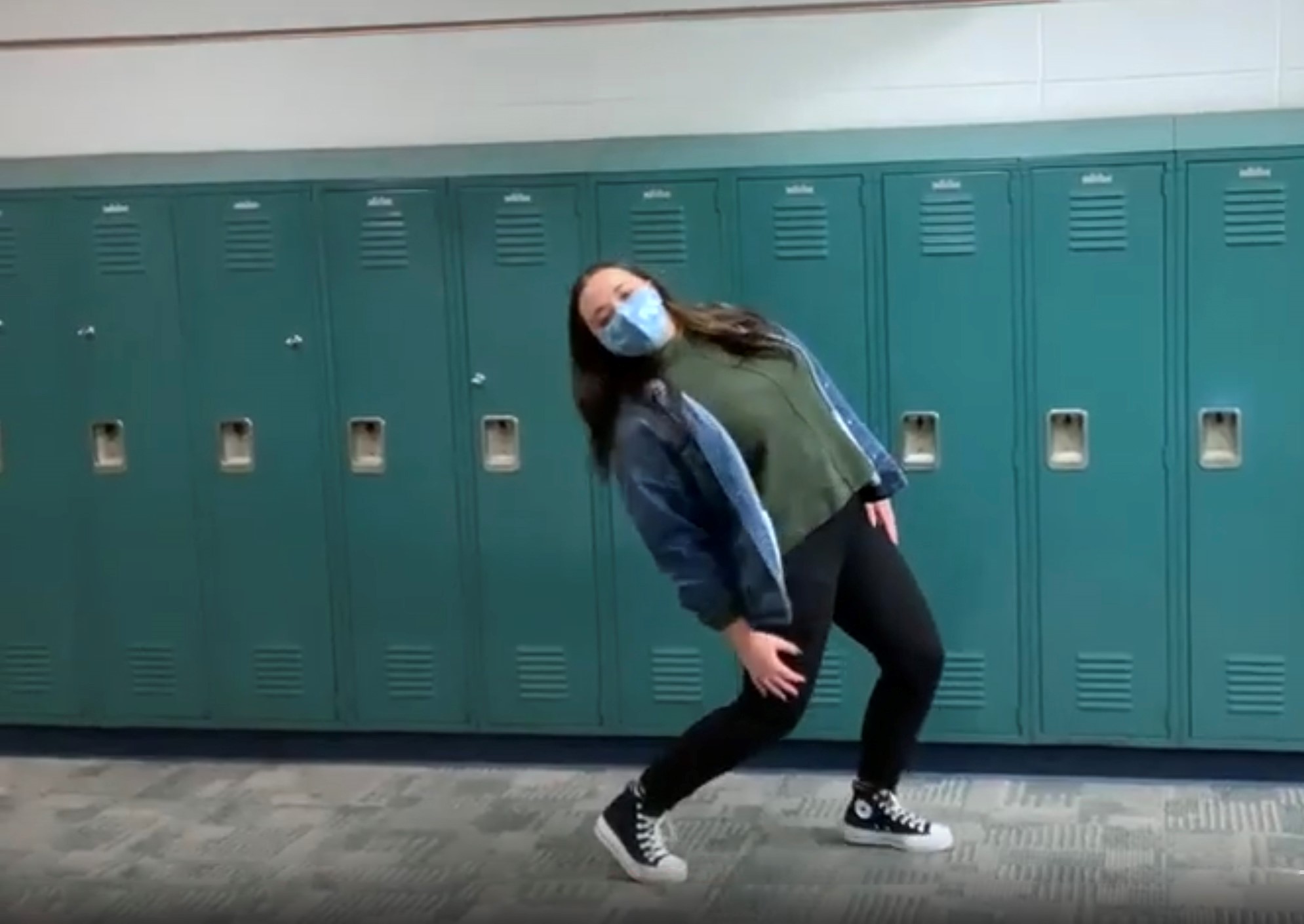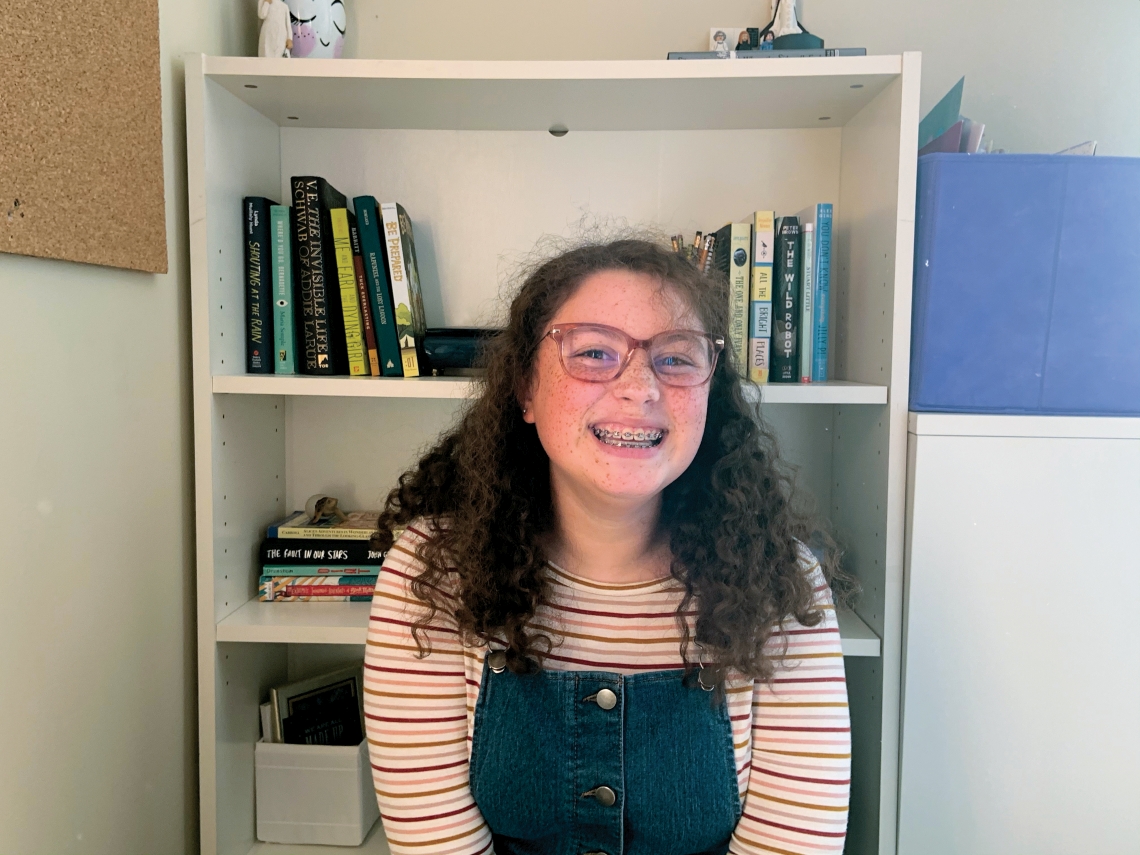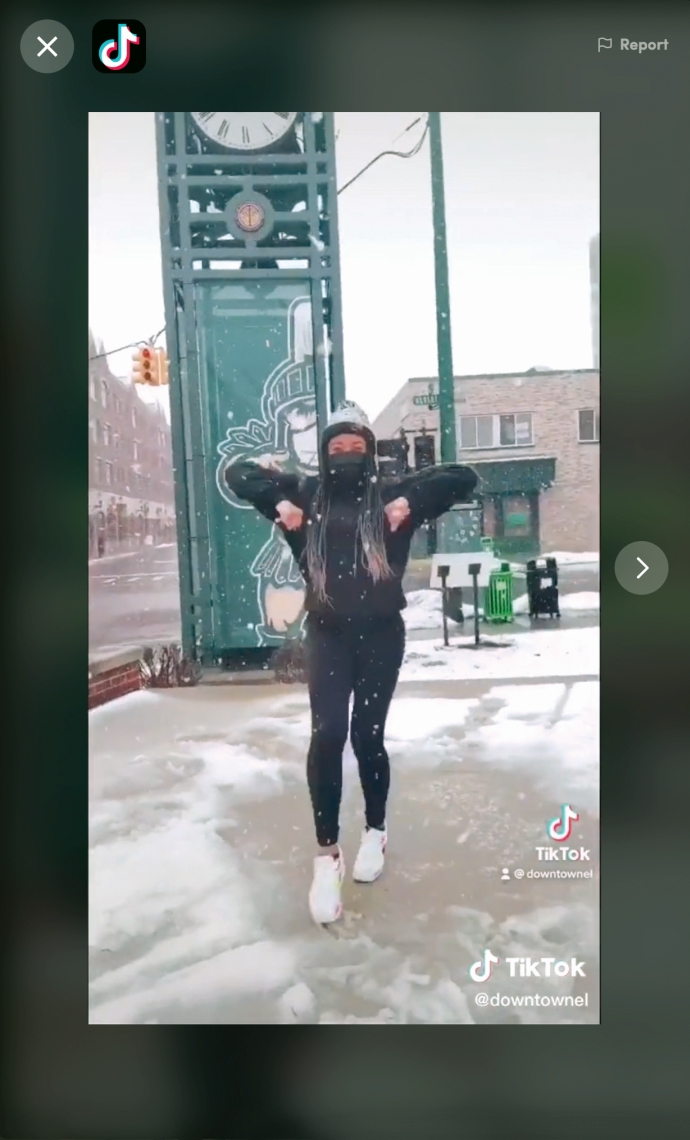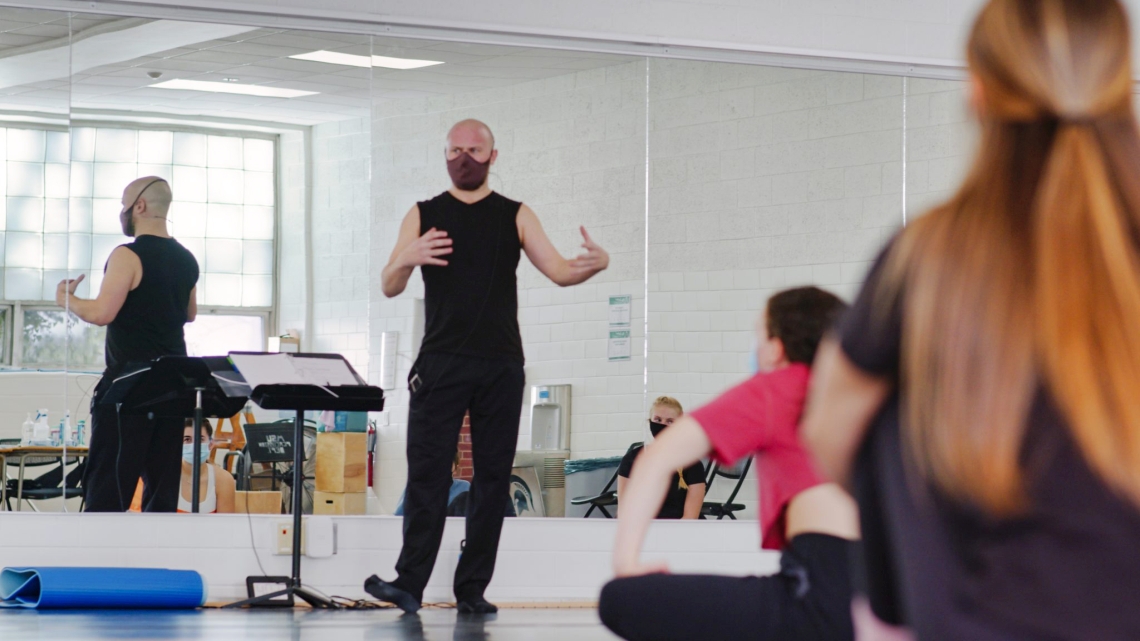Commemorating the Year of COVID in Dance and Spoken Narrative
- Brad Willcuts, MFA
- Assistant Professor, Department of Theatre
- College of Arts and Letters

Olivia Walters performs her dance interpretation of "The Day It All Began," written by Emmerson Davis.
Dance is for the most part a social thing. People tend to dance together. So you might think doing collaborative dance projects during a pandemic lockdown would be impossible.
Brad Willcuts thinks otherwise.
Willcuts is an assistant professor who teaches musical theatre and choreography in MSU's Department of Theatre. He has a long-standing interest in virtual reality and other technological enhancements to the performance experience.
He is also always on the lookout for projects that engage with the public. Currently he has several irons in the fire.
"The Day It All Began": Dancing the Pandemic
One collaboration got its start when Willcuts happened to get into conversation with East Lansing High School visual arts instructor Jacqueline Carroll, who lives in his neighborhood. Their two families became friends after Carroll's family moved to Lansing last year.
Carroll had earlier done a project with spoken word poetry to get students thinking about finding symbols to express subjective reactions to the poetry. She and Willcuts put their heads together and created a joint lesson plan for the fall 2020 semester.
Carroll's high school students each wrote a story about their experience with the quarantine and their classmates then recorded vocal readings of the stories. Willcuts brought seven MSU students from his Choreography and Composition class (DAN 354) to the mix. His students choreographed and danced the stories in solo videos, each narrated by one of the story writer's classmates.

Emmerson Davis, East Lansing High School student.
Carroll attributed much of the project's success to her students' realizing that their work would be read and translated into a new art form. She said, "Just the fact that most high school writing doesn't extend beyond the teacher creates a culture of apathy. This translation opens the mind to the potential within any creative outlet they follow."
Jake Price, an MSU arts and humanities student in the DAN 354 class who was one of the choreographers on the project, said, "This collaboration displayed the importance of community outreach and dance, as it gave young high-schoolers a chance to see their stories come to fruition through dance. Brad curated a course that trained aspiring choreographers to think creatively and analytically about dance."
Emmerson Davis, a student in Carroll's class who wrote "The Day It All Began," thought it was a wonderful project: "I really enjoyed doing it. When Ms. Carroll announced it I was a little bit skeptical. But after getting into it and writing my story, hearing that it was going to be turned into a dance was cool. The video of the dance was really cool." She said the most important thing she learned was that stories aren't only written: "They can also be received through dance or through movement or through hearing them. Seeing something that I wrote turned into a different thing that still conveys the same message is mind-boggling."
Carroll and Davis were completely in sync about one thing: How to encourage creativity.
Carroll's advice was, "Make friends. Allow opportunities that fall into your lap to happen. Brad and his family live two doors down from us. I work in English and art, Brad is more movement-based. But we got talking about 'what if we do this,' and in no time we had a project going. When these moments occur, pursue them."
Davis agreed. "Give new things a try," she said. "I did not think my story could be turned into a dance, or that it could be read in a different way than how I had written it in my head. Give it a try, because it turned out amazing and I'm really happy with everything about it."
The project culminated in a virtual "show and tell" day at the end of the semester. The students were all in attendance and Carroll had made "this wonderful Google forum where we could see pictures, and we all put up pictures of ourselves when we were in seventh grade," said Willcuts. "We've got the ball rolling now. Hopefully we will be collaborating a lot more in the future."
View the student videos
TikTok Challenge with Downtown East Lansing Development Authority

Jaylin Coleman performs the dance she created for the TikTok Challenge with Downtown East Lansing Authority.
In January 2021, East Lansing's Downtown Development Authority (DDA) launched a TikTok Challenge on the theme of "Daytime. Nighttime. Anytime. Place Project" to promote downtown businesses. Contestants were asked to record a video of themselves, first performing a dance in front of a downtown EL business or landmark and then following it up with their own improvisations. Willcuts and MSU media and information student Jaylin Coleman choreographed a dance for the prototype to post on the city's website, and Coleman performed it. The winner of the contest received a $200 Downtown East Lansing eGift Card from the DDA.
Coleman has been in Willcuts' jazz and contemporary class for two semesters, and "loved every second with it. As a creative and a dancer, Brad has personally pushed me beyond my comfort zone and limits. We collaborated on the choreography for the Downtown East Lansing project, and it was a positive experience for me to learn from a working professional, while also contributing my own style and sass into the choreography."
View the TikTok video
ĭmáGen: Collaborating with Broadway Professionals
For the past seven years the ĭmáGen program has brought six people from New York to MSU to work on a show they want to bring to Broadway. "It's one of my favorite things," said Willcuts. "This year we had to do it all online. Over the last few weeks with the Broadway professionals, we were all waxing emotional about the end of the process."
He said all of the Broadway people had started out saying that being online was "weird, it doesn't make sense, I need to be in the room with students." But by the end of it, "we had been able to dig in so much more to the purpose and craft of working on a show and story. You never get that opportunity when you're in a commercial space, because time is money. It's the lights and the costumes and the marketing, and so on."
According to Willcuts, this year's production was one of the better ones they had ever done, because they were forced to find their way without the glitz. "In a weird way, trying to find the silver lining in the restrictions sets you free," he said.
Creative Arts and Humanities: The Creative Process (IAH 241E)

Assistant professor Bradley Willcuts teaches a class.
In the spring of 2018 Willcuts was tasked with creating an Integrative Studies in the Arts and Humanities course on the creative process (IAH 241E). He set out to create a social dance course that went back through time. He read about dance in a wide variety of times and cultures, and thought about what values from those cultures spill out into their dance forms. Over the spring semester of 2018, the students spent one day a week in the lecture hall and one day in the dance studio, doing everything from the waltz and the gavotte and the mambo to an ancient Greek war dance.
Then he got rid of lecturing and started interviewing professionals on podcasts so the students wouldn't have to just sit and watch a PowerPoint.
By summertime he had begun working to make the class available online. "I actually pivoted this class towards online before the pandemic hit," he said. He paired up with colleague Daniel Trego, an educational and media design specialist at the College of Arts and Letters who has since become a regular partner and friend, for help figuring out the transition: "What Dan helped me do is reimagine how the class could still be engaging and experiential, but without actually having to be next to one another."
They went in two opposite directions at once to accomplish this. One direction involved taking all context out of the discussion by putting motion-capture suits on some dancers, making videos, and showing the dancing avatars to the students. "You don't see gender, you don't see race, you don't see costume or environment, you just see a body moving," said Willcuts.
The students interpreted by trying to guess or create a context for the dances: Was it like John Travolta in Saturday Night Fever? A Greek wedding dance? A dance at a club?
The other direction was to bring in the full cultural context by building a virtual reality experience that puts students right into the setting for the dance. With assistance from Trego, Willcuts' goal is "to have costumes in the set so they can literally walk up to a sock hop in the 1950s, and see some of my dancers in class, like in poodle skirts. And then step into it. Or different civilizations, where students can 'go back in time' and ask questions." He is hoping to have this ready by summer semester 2021.
The average student who takes an IAH course is not necessarily involved in dance or performance. "So, when they're surrounded by their peers, and asked to waltz and mambo together, they shut down. It takes a while for them to express themselves," said Willcuts. "However, when they're on film, they don't feel like they're being judged, so they figure out how to mimic the teaching. Then when they upload their videos, their inhibitions really melt away and they are able to access the dance."
Regarding the collaboration to develop this class, Trego commented, "My work with digital media is centered around exploring ways to create deeper, more meaningful connections amongst students, professors, and course content. Working with Brad has brought another dimension of engagement that I had always wanted to explore but never had the right context. We have been able to bring students together in different 'spaces' that both value their unique social and cultural contexts and provide opportunities to broaden their perspectives and understanding."
Musical Theatre Acting Class
"We have collaborated on at least six fully produced musicals. Brad sets the bar at its highest level for everyone involved, the creative team, the actors, the musicians. His energy in the room is infectious and propels actors and creatives together."
Dave Wendelberger
Musical Theater Faculty
Willcuts co-teaches a musical theatre acting class with Dave Wendelberger, who is also an instructor on the Musical Theatre faculty. This was the class that took the worst hit when the pandemic arrived.
Willcuts and Wendelberger, along with Trego, responded by doubling down on teaching the students to create their own content—how to edit video, lip sync, harmonize with themselves, create tracks—all the techniques to crisp up the voice and the production. Professionals they have talked to since have all said they wish they'd had that skill set when they were younger because they use it all the time now.
Wendelberger summed up what it's like to work with Willcuts by saying, "We have collaborated on at least six fully produced musicals. Brad sets the bar at its highest level for everyone involved, the creative team, the actors, the musicians. His energy in the room is infectious and propels actors and creatives together."
Willcuts said, "We all went through some dark, tough times. But the videos in that class were far better than the ones in basic studio; the project has turned into something that will always be part of the class." Overall, he thinks the pandemic experience has been rough for students but believes that at least for some, "it's increased their grit. They're stronger for it."
NOTE: This work was supported in part by a Catalyst grant and a Faculty Fellowship, both from the MSU Hub for Innovation in Learning and Technology.
- Written by Linda Chapel Jackson, University Outreach and Engagement
- Photographs courtesy of Mike Davis and MSU College of Arts and Letters